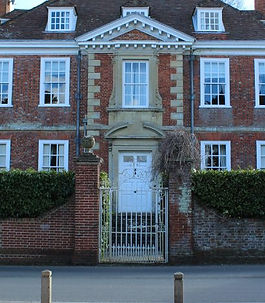The beacon at the junction of Moot Lane with Lode Hill was erected in 2000 as part of the village's millennium celebrations. The land here was cleared following the demolition of a pair of cottages to allow highway improvements at the junction in the 1970s. The adjacent house, Moot Villa, was once occupied by a shirt maker and later the village midwife.
The Moot House, formerly known as Downton House, is a grade 1 listed building. the house was originally built circa 1700. However, its interior mostly dates from after 1923, when the house was gutted by a disastrous fire. During the fire, a maid named Gwendoline Burnham jumped from an upstairs window in panic and landed on the cook, Mrs Annie Wilson, who was fatally injured. Her ghost is said to haunt the site although, somewhat confusingly, this spirit is sometimes said to have manifested itself as a face at the first floor window.
The Moot ornamental gardens are located opposite the house. Bishop Blois was said to have built a castle in Downton in 1138. The Moot seems to be the most likely site, although no traces have been found so it is unlikely that any permanent structure was built.
During late Victorian and early Edwardian summers, the Moot gardens were used for a number of fundraising fetes and bazaars. The events lasted for up to three days at a time. Special trains were laid on to and from Salisbury and up to 3000 people attended. As well as the usual stalls, dances and fireworks, the events also included open-air performances of Shakespeare plays. Sybil Thorndike played Adriana in ‘A Comedy Of Errors’ here in 1908.
The Moot is a Scheduled Ancient Monument and is now owned and managed by a charitable company. The administration and much of the maintenance of the site is carried out by volunteers.
Immediately beyond the gardens are the current village surgery and a recreation ground. Until the 1950s there had been very little development in Moot Lane beyond this point and Moot Farm, on the opposite side of the road. The lane had been lined with high banks and chestnut trees but improvements in methods of water supply meant that this relatively high and hard, chalky ground away from the river could now be built upon.
The area where council housing was built in Castle Meadow had in fact been where the first known Downton people lived. Beaker, Neolithic and Mesolithic items were found here during archaeological surveys in 1956 and 1957. Saxon and Medieval features were also found in the area during further excavations in 1962.
In 1953, on the opposite side of Moot Lane, part of the tessellated floor of a Roman villa was discovered by the occupier of a newly built property in Moot Close, who was apparently digging a hole for a new washing line post. Mr Morley-Hewitt of Fordingbridge, who had connections with the site of the villa at Rockbourne, carried out investigative works and, during 1955 and 1956, the Ministry of Public Building and Works excavated the remainder of the site.
Although part of the original site was inaccessible due to the railway to the east, the excavations covered most of the rear gardens from 5 to 12 Moot Close. Part of the floor of the villa can now be seen in the Salisbury and South Wiltshire Museum.
Just beyond the southern end of the now built-up part of Moot Lane, Pile Bridge carried the old railway line across the River Avon.

